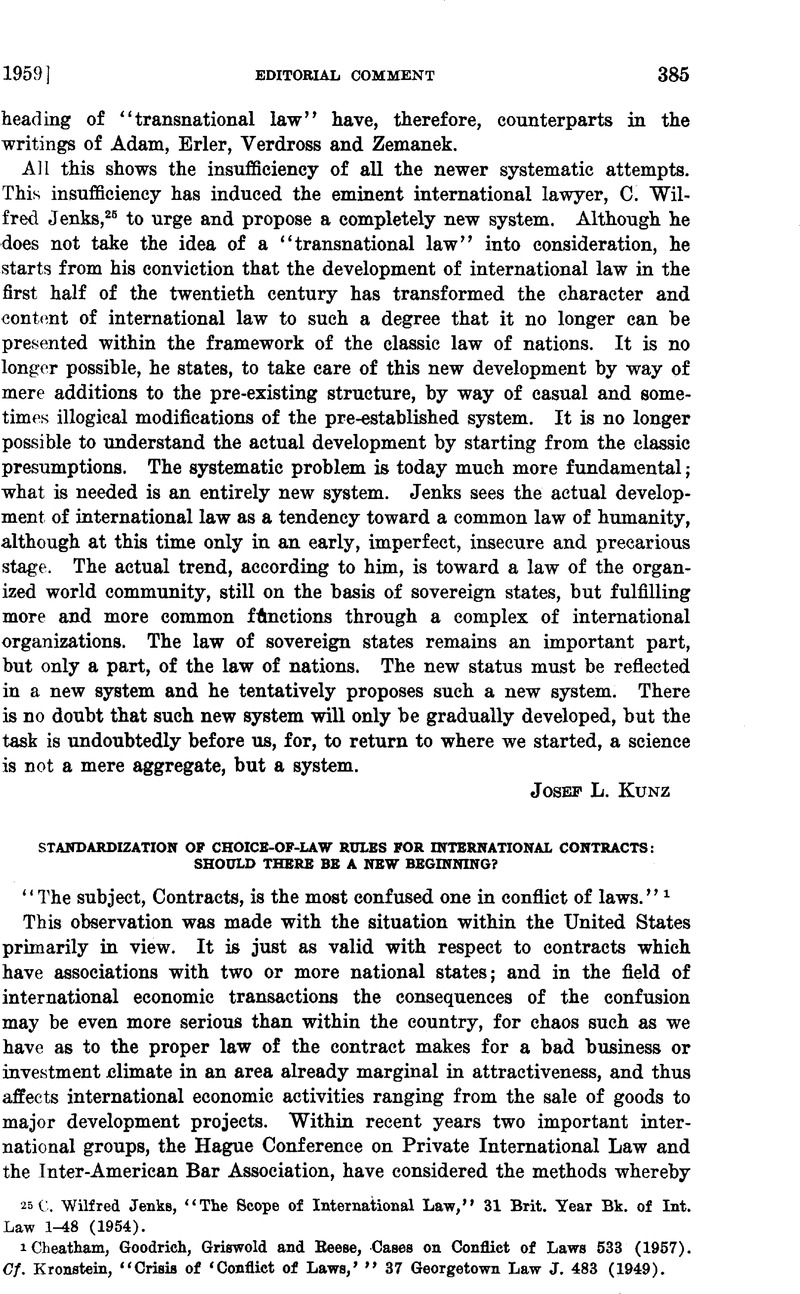No CrossRef data available.
Published online by Cambridge University Press: 28 March 2017

1 Cheatham, Goodrich, Griswold and Keese, Cases on Conflict of Laws 533 (1957). Cf. Kronstein, , “Crisis of ‘Conflict of Laws,’ “ 37 Georgetown Law J. 483 (1949).Google Scholar
2 The writer has heard from more than one source expressions of puzzlement at the seeming lack of official United States interest in group efforts along these lines. Cf. Eeese, “Some Observations on the Eighth Session of the Hague Conference on Private International Law,” 5 A. J. Comp. Law 611 (1956).
3 For a current estimate of the challenge, the need and the prospects for a uniform substantive law of international sales transactions, see Honnold, “ A Uniform Law for International Sales,” 107 U. Pa. Law Rev. 299 (1959).
4 Nadelmann, and Reese, , ‘ ‘ The American Proposal at the Hague Conference on Private International Law to Use the Method of Uniform Laws,” 7 A. J. Comp. Law 239 (1958).Google Scholar
5 For an effort at appraisal of standard Department of State reticence prior to the Bricker amendment episode, see Oliver, Statement and Testimony to Subcommittee of the Senate Judiciary Committee, 83rd Cong., 1st Sess., Eecord of Hearings 683-695 (1953). The press has reported various instances in which this reticence appears to have become extreme since then.
6 Erie Bailroad v. Tompkins, 304 TJ. S. 64 (1938) ; Klaxon Co. v. Stentor Electric Mfg. Co., 313 U. S. 487 (1941). For an important argument, inter alia, in the context of this discourse, that the Erie case elimination of Federal general jurisprudence should not be held to deprive the Federal Government, under its power over foreign relations, of authority to make State law conform to federally accepted views of international law as a part of the law of the land, see Jessup, , “The Doctrine of Erie Railroad v. Tompkins Applied to International Law,” 33 A.J.I.L. 740 (1939).Google Scholar
7 The classic one is Cook, The Logical and Legal Bases of the Conflict of Laws (1942). The latest from the presses is Ehrenzweig, Conflict of Laws, Pt. One, passim, and 6-10 (1959).
8 Professor Currie's thesis is developed in “Married Women's Contracts: A Study in Conflict-of-Laws Method,” 25 TJ. of Chicago Law Eev. 227 (1958); “Survival of Actions: Adjudication Versus Automation in the Conflict of Laws,” 10 Stanford Law Eev. 205 (1958); “On the Displacement of the Law of the Forum,” 58 Col. Law Bev. 964 (1958).
9 Levin, , “Party Autonomy: Choice-of-Law Clauses in Commercial Contracts,” 46 Georgetown Law J. 260 (1957).Google Scholar
10 “ ‘Public Policy’ in the Conflict of Laws,” 56 Col. Law Eev. 969, 1015-16 (1956).
11 “Adhesion Contracts in the Conflict of Laws,” 53 Col. Law Eev. 1072 (1953).
12 A good beginning would include Yntema, “'Autonomy’ in Choice-of-Law,” 1 A.J. Comp. Law 341 (1952); see also Batiffol, “Conflict Avoidance in European Law,” Symposium on Conflict Avoidance, 21 Law and Contemporary Problems 571 (1956).
13 International Trade Arbitration (American Arbitration Association, 1958, Domke, ed.) is a very useful source book. As to the present situation in the United States with respect to (1) State laws on arbitration, (2) treaty practice, (3) the Federal Arbitration Act, and (4) a prediction that the United States will stand aloof from the arbitration proposals made by the Economic and Social Council, consult Hynning, “A Comparison of British and American Policies on International Commercial Arbitration,” loc. tit. above, pp. 117-136. For the United Nations proposals resulting from the 1958 Conference, see Haight, Summary Analysis of Record of the United Nations Conference and Convention on the Recognition and Enforcement of Foreign Arbitral Awards, May/June, 1958 (published in offset, apparently by the International Chamber of Commerce, 1958) ; and Domke, this Journal, p. 414, below.